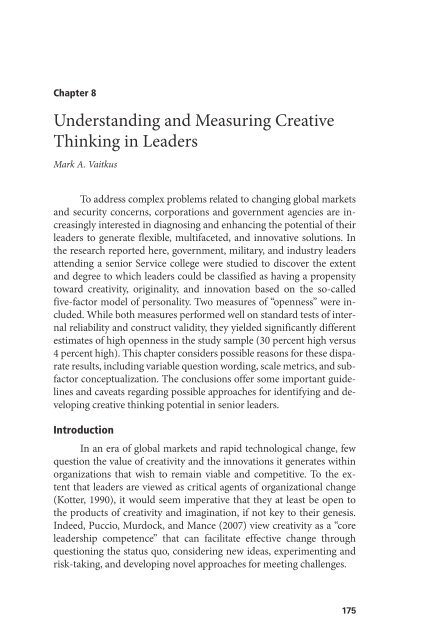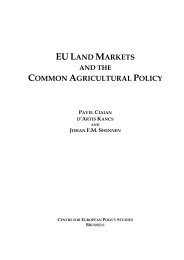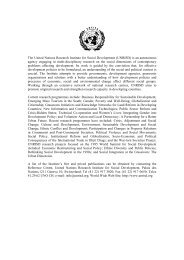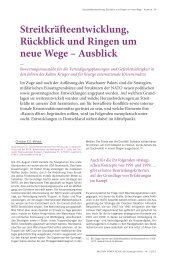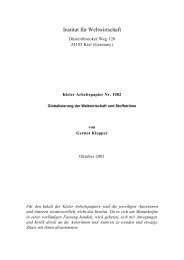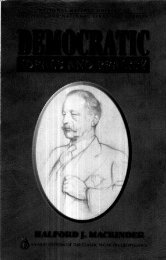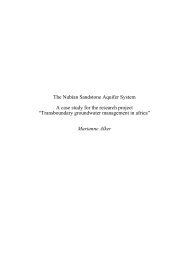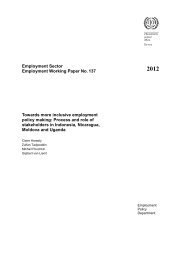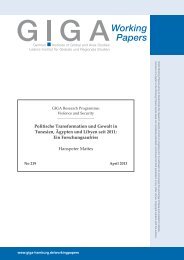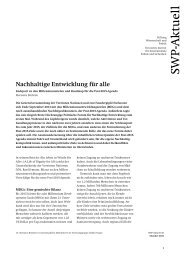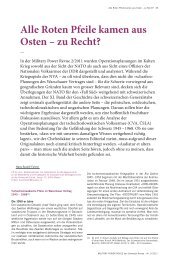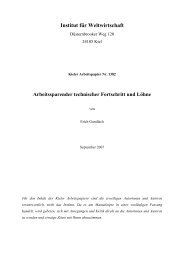Understanding and Measuring Creative Thinking in Leaders
Understanding and Measuring Creative Thinking in Leaders
Understanding and Measuring Creative Thinking in Leaders
You also want an ePaper? Increase the reach of your titles
YUMPU automatically turns print PDFs into web optimized ePapers that Google loves.
Chapter 8<strong>Underst<strong>and</strong><strong>in</strong>g</strong> <strong>and</strong> <strong>Measur<strong>in</strong>g</strong> <strong>Creative</strong><strong>Th<strong>in</strong>k<strong>in</strong>g</strong> <strong>in</strong> <strong>Leaders</strong>Mark A. VaitkusTo address complex problems related to chang<strong>in</strong>g global markets<strong>and</strong> security concerns, corporations <strong>and</strong> government agencies are <strong>in</strong>creas<strong>in</strong>gly<strong>in</strong>terested <strong>in</strong> diagnos<strong>in</strong>g <strong>and</strong> enhanc<strong>in</strong>g the potential of theirleaders to generate flexible, multifaceted, <strong>and</strong> <strong>in</strong>novative solutions. Inthe research reported here, government, military, <strong>and</strong> <strong>in</strong>dustry leadersattend<strong>in</strong>g a senior Service college were studied to discover the extent<strong>and</strong> degree to which leaders could be classified as hav<strong>in</strong>g a propensitytoward creativity, orig<strong>in</strong>ality, <strong>and</strong> <strong>in</strong>novation based on the so-calledfive-factor model of personality. Two measures of “openness” were <strong>in</strong>cluded.While both measures performed well on st<strong>and</strong>ard tests of <strong>in</strong>ternalreliability <strong>and</strong> construct validity, they yielded significantly differentestimates of high openness <strong>in</strong> the study sample (30 percent high versus4 percent high). This chapter considers possible reasons for these disparateresults, <strong>in</strong>clud<strong>in</strong>g variable question word<strong>in</strong>g, scale metrics, <strong>and</strong> subfactorconceptualization. The conclusions offer some important guidel<strong>in</strong>es<strong>and</strong> caveats regard<strong>in</strong>g possible approaches for identify<strong>in</strong>g <strong>and</strong> develop<strong>in</strong>gcreative th<strong>in</strong>k<strong>in</strong>g potential <strong>in</strong> senior leaders.IntroductionIn an era of global markets <strong>and</strong> rapid technological change, fewquestion the value of creativity <strong>and</strong> the <strong>in</strong>novations it generates with<strong>in</strong>organizations that wish to rema<strong>in</strong> viable <strong>and</strong> competitive. To the extentthat leaders are viewed as critical agents of organizational change(Kotter, 1990), it would seem imperative that they at least be open tothe products of creativity <strong>and</strong> imag<strong>in</strong>ation, if not key to their genesis.Indeed, Puccio, Murdock, <strong>and</strong> Mance (2007) view creativity as a “coreleadership competence” that can facilitate effective change throughquestion<strong>in</strong>g the status quo, consider<strong>in</strong>g new ideas, experiment<strong>in</strong>g <strong>and</strong>risk-tak<strong>in</strong>g, <strong>and</strong> develop<strong>in</strong>g novel approaches for meet<strong>in</strong>g challenges.175
176 THE 71F ADVANTAGEThis chapter exam<strong>in</strong>es <strong>and</strong> compares two conventional psychologicalmeasures of creative disposition with<strong>in</strong> a senior leader population.Both measures view such a disposition under the rubric of “openness”with<strong>in</strong> the so-called big five or five-factor model of personality.The analysis will attempt to answer the follow<strong>in</strong>g questions:■ Is each measure of openness reliable <strong>and</strong> valid <strong>in</strong> its ability todifferentiate this factor from other personality factors?■ How different are the measures <strong>in</strong> terms of describ<strong>in</strong>g thispopulation with respect to creative proclivities, <strong>and</strong> what accountsfor these differences?■ What are the caveats that leader developers should keep <strong>in</strong>m<strong>in</strong>d when us<strong>in</strong>g these <strong>and</strong> other “st<strong>and</strong>ard” measures of personalityto screen for creative qualities, <strong>and</strong> how should suchcaveats <strong>in</strong>form feedback <strong>and</strong> tra<strong>in</strong><strong>in</strong>g programs?Personality Conceptualization <strong>and</strong> the Five-factor ModelS<strong>in</strong>ce the early 1990s, there has been considerable convergence<strong>in</strong> the field of personality assessment toward a five-factor or “Big Five”measurement model (John <strong>and</strong> Srivastava, 1999). Movement toward afive-factor taxonomic model of personality can be traced back to Fiske(1949), Tupes <strong>and</strong> Christal (1961/1992), <strong>and</strong> Norman (1963), who builton, <strong>and</strong> partially replicated, Cattell’s (1945) factor analytic work, conclud<strong>in</strong>gthat five factors adequately described the analytical space of extantpersonality trait measures (John <strong>and</strong> Srivastava, 1999). In their reviewof published studies to that time, Digman <strong>and</strong> Takemoto-Chock(1981) <strong>and</strong> Goldberg (1981, 1993) reaffirmed that the Big Five did <strong>in</strong>deedcapture the most generalizable categorization of personality characteristics.Follow<strong>in</strong>g Digman (1990), we may describe these as follows:■ Surgency or extraversion. Those who score higher on this factortend to enjoy the stimulation that comes from <strong>in</strong>teract<strong>in</strong>gwith large numbers of people <strong>in</strong> whose company they are generallytalkative <strong>and</strong> assertive. They are not shy <strong>and</strong> have a highdegree of positive energy that leads them to actively engage <strong>in</strong>a wide variety of activities.■ Agreeableness. Individuals who display higher agreeablenesstend to be k<strong>in</strong>d <strong>and</strong> value cooperation <strong>and</strong> gett<strong>in</strong>g along with
UNDERSTANDING AND MEASURING CREATIVE THINKING IN LEADERS 177others. They are more sensitive to, <strong>and</strong> concerned about, thefeel<strong>in</strong>gs of others, more likely to give people the benefit of thedoubt, <strong>and</strong> will often compromise to avoid conflict <strong>and</strong> theprospect that others will not like them.■ Conscientiousness. People report<strong>in</strong>g higher levels of conscientiousnessdesire orderl<strong>in</strong>ess, organization, <strong>and</strong> efficiency <strong>in</strong> theirlives. They take their perceived responsibilities <strong>and</strong> duties veryseriously, <strong>and</strong> have considerable <strong>in</strong>vestment <strong>in</strong> view<strong>in</strong>g themselvesas dependable, thorough, <strong>and</strong> achievement-oriented.■ Emotional stability. Those exhibit<strong>in</strong>g greater emotional stabilityreport relative freedom from experienc<strong>in</strong>g “negative feel<strong>in</strong>gs”such as anger, anxiety, <strong>and</strong> depression. They are also lesslikely to be moody, mercurial, <strong>and</strong> temperamental. In general,they will display calmness <strong>and</strong> less nervousness than those whoscore low on this factor. Some researchers have preferred toconcentrate on its opposite pole <strong>in</strong>stead (that is, the negativefeel<strong>in</strong>gs themselves), <strong>and</strong> thus label it “neuroticism.”■ Openness. Variably called culture, <strong>in</strong>tellect, <strong>and</strong> openness toexperience, this factor attempts to measure dispositions thatskew toward higher curiosity, imag<strong>in</strong>ation, <strong>and</strong> creativity.Those on the higher end may th<strong>in</strong>k of themselves as be<strong>in</strong>gmore open-m<strong>in</strong>ded <strong>and</strong> appreciative of the arts, while alsovalu<strong>in</strong>g orig<strong>in</strong>ality, new experiences, <strong>and</strong> deep or <strong>in</strong>tellectualreflection.The dimension labeled openness clearly comes closest to describ<strong>in</strong>gthe personality factor l<strong>in</strong>ked to a creative disposition <strong>and</strong> its cont<strong>in</strong>gentlean<strong>in</strong>gs or preferences, <strong>and</strong> therefore the one on which I will focus<strong>in</strong> this chapter.Openness <strong>and</strong> Organizational Leader EffectivenessOpenness is probably the least understood of the five personalityfactors. Part of the problem lies squarely with poor conceptualization<strong>and</strong> attempts to variably describe the factor as a disposition towardcritical th<strong>in</strong>k<strong>in</strong>g <strong>and</strong> <strong>in</strong>quisitiveness (<strong>in</strong>tellect), a need for variety <strong>and</strong>new experiences, a tendency to be creative <strong>and</strong> imag<strong>in</strong>ative, an <strong>in</strong>terest<strong>in</strong> aesthetic pursuits <strong>and</strong> the arts, an antiauthoritarian orientation,<strong>and</strong> an empathy with or underst<strong>and</strong><strong>in</strong>g of diverse others (McCrae <strong>and</strong>Costa, 1997). Such subdimensions do not always correlate well with one
178 THE 71F ADVANTAGEanother <strong>in</strong> analyses, certa<strong>in</strong>ly when compared to the other four factors.Yet such effects of openness on the endorsement of liberal political <strong>and</strong>social values (McCrae, 1996; Van Hiel <strong>and</strong> Mervielde, 2004), as well asliberal c<strong>and</strong>idates for political office (Caprara <strong>and</strong> Zimbardo, 2004), arefairly well documented. Of the Big Five, openness also comes closest topredict<strong>in</strong>g personal exploration of spiritual phenomena (versus hold<strong>in</strong>gconventional beliefs) <strong>and</strong> the profession of virtues such as forgiveness(MacDonald, 2000). To the extent that we are talk<strong>in</strong>g about an activecuriosity about the unknown, a desire to experience the unfamiliar,tak<strong>in</strong>g an orig<strong>in</strong>al <strong>and</strong> <strong>in</strong>novative approach to problems, <strong>and</strong> not shy<strong>in</strong>gaway from the complex or abstract, such qualities of the “open” personalitymay <strong>in</strong>deed be functional for the executive leader operat<strong>in</strong>g <strong>in</strong> anambiguous <strong>and</strong> culturally diverse strategic environment.Psychometric measures of basic <strong>in</strong>telligence are correlated withopenness (DeYoung, Peterson, <strong>and</strong> Higg<strong>in</strong>s, 2005; McCrae <strong>and</strong> Costa,1997). There is also little doubt that openness is an important <strong>in</strong>gredient<strong>in</strong> what Thomas (2006; cf. Earley, 2002) calls “cultural <strong>in</strong>telligence”(or “cultural quotient” [CQ]) (Thomas, 2007, <strong>and</strong> Earley, 2002) or “theability to <strong>in</strong>teract effectively with people who are culturally different.”Coupled with a desire for new cultural experiences, another aspect ofopenness, CQ is further enhanced. However, while personality factorssuch as openness are related to the raw capacity for CQ development,the latter rema<strong>in</strong>s dist<strong>in</strong>ct from its actual development or exhibition <strong>in</strong> aparticular circumstance, which depends on <strong>in</strong>teractional experiences asmuch as the <strong>in</strong>dividual’s motivation (Thomas).In terms of studies that have looked at Big Five models of personalitywith respect to leadership criteria variables, Judge, Ilies, Bono,<strong>and</strong> Gerhardt (2002) f<strong>in</strong>d the follow<strong>in</strong>g correlational averages with effectiveleadership outcomes across 73 samples: extraversion (.31), conscientiousness(.28), openness to experience (.24), neuroticism (-.24),<strong>and</strong> agreeableness (.08). While just 23 percent of the variance <strong>in</strong> positiveleadership outcomes across samples was expla<strong>in</strong>ed by personality differences,this is a significant number <strong>and</strong> demonstrates that personality, <strong>in</strong>clud<strong>in</strong>gopenness, should <strong>in</strong>deed be considered part of the variable solutionset for model<strong>in</strong>g leadership.In his most comprehensive attempt to lay out an <strong>in</strong>tegrated theoryof executive leadership based on a meta-analysis of dozens of ArmyResearch Institute <strong>and</strong> other studies, Zaccaro (2001) identifies such
UNDERSTANDING AND MEASURING CREATIVE THINKING IN LEADERS 179personality characteristics as openness, curiosity, flexibility, adaptability,<strong>and</strong> risk propensity as all be<strong>in</strong>g requisite for executive effectiveness beyondexpertise, <strong>in</strong>telligence, <strong>and</strong> other cognitive capacities. Streufert <strong>and</strong>Swezey (1986) also provide evidence <strong>in</strong> the civilian sector that executiveswho possess greater “multidimensional th<strong>in</strong>k<strong>in</strong>g” make better decisions<strong>and</strong>, therefore, more valuable contributions to their organizations.When it comes to the special case of transformational leadership,the results for Big Five l<strong>in</strong>kages are somewhat different than for leadershipgenerally. In their review of study results from 14 samples of leadersrepresent<strong>in</strong>g over 200 organizations, Judge <strong>and</strong> Bono (2000) reportthat transformational leader behaviors had moderate zero-order associationswith higher extraversion, agreeableness, <strong>and</strong> openness. Surpris<strong>in</strong>gly,there were no significant effects for neuroticism <strong>and</strong> conscientiousness.In a more sophisticated analysis <strong>in</strong>corporat<strong>in</strong>g a militarysample, Ployhart, Lim, <strong>and</strong> Chan (2001) employed structural equationmodel<strong>in</strong>g that differentiated “typical” versus “maximum” performancecriteria related to transformational leadership to show that extraversionwas strongly predictive of both types of criteria, but openness had predictivepower only for the maximum criteria, <strong>and</strong> low neuroticism wasexclusively related to the typical performance criteria.Along with a highly developed conceptual capacity, deeply heldethical values, <strong>and</strong> a mature <strong>and</strong> flexible perspective, Jacobs (2006) believesthat openness is a critical attribute of transformational leaders becauseit enables them to consider new ideas <strong>and</strong> solutions without dismiss<strong>in</strong>gthem based on preconceived notions. Indeed, Jacobs states flatlythat openness, <strong>in</strong> terms of a disposition toward <strong>in</strong>tellectual curiosity,imag<strong>in</strong>ation, <strong>and</strong> creative problem-solv<strong>in</strong>g, may well be the most importantBig Five dimension for strategic leadership. This is partially becausestrategic leaders must not only be able to apply a systems perspectiveto gaug<strong>in</strong>g their organization’s environment <strong>in</strong> time <strong>and</strong> space, butthey also must take that necessarily complex underst<strong>and</strong><strong>in</strong>g, fashion avision for an organizational path forward consistent with that underst<strong>and</strong><strong>in</strong>g,<strong>and</strong> communicate that vision <strong>in</strong> an effectively parsimonious,mean<strong>in</strong>gful, clever, <strong>and</strong> ideally orig<strong>in</strong>al <strong>and</strong> <strong>in</strong>spir<strong>in</strong>g manner.It should be noted that openness is not a panacea, especially whentaken to an extreme. Jacobs (2006) makes it clear that “[t]op-level executivesmust underst<strong>and</strong> the necessity to fix it even ‘when it a<strong>in</strong>’t broke’”<strong>and</strong> that openness helps a strategic leader be functionally proactive <strong>in</strong>
180 THE 71F ADVANTAGEthis regard. At the same time, an executive with an extremely high drivefor openness may <strong>in</strong>itiate change for its own sake to fulfill a thirst forstimulation <strong>and</strong> excitement, thus squ<strong>and</strong>er<strong>in</strong>g resources <strong>and</strong> putt<strong>in</strong>gthe organization at unnecessary risk (Jacobs). Openness is ultimately nodifferent, therefore, than the other dimensions of personality <strong>in</strong> terms ofthe need to achieve a reasonable balance. However, there is little doubtthat its elements are closely tied to an aff<strong>in</strong>ity for the k<strong>in</strong>d of creativeproblem-solv<strong>in</strong>g <strong>and</strong> complex th<strong>in</strong>k<strong>in</strong>g skills associated with effectiveleadership <strong>in</strong> volatile <strong>and</strong> chang<strong>in</strong>g environments (Puccio, Murdock,<strong>and</strong> Mance, 2007; Yukl, 2002), <strong>and</strong> therefore with the leader behaviorsassociated with transformational, charismatic, <strong>and</strong> visionary leadership(House <strong>and</strong> Shamir, 1993).MethodParticipantsThe subjects <strong>in</strong> this study were students attend<strong>in</strong>g a U.S. Governmentsenior Service college dur<strong>in</strong>g the 2006–2007 academic year. Thepresent study was reviewed <strong>and</strong> approved by the Institutional ReviewBoard at the National Defense University, <strong>and</strong> completion of any one ormore of the <strong>in</strong>struments was voluntary with the guarantee that all <strong>in</strong>dividualresults would rema<strong>in</strong> confidential.All 292 U.S. students <strong>in</strong> the class completed either or both of thetwo <strong>in</strong>struments under exam<strong>in</strong>ation here. Four <strong>in</strong>ternational fellowsalso did so, but these subjects were removed from the analysis. Demographicdata were available for 266 of the U.S. students. Of these, 75.6percent (201) were male, <strong>and</strong> 24.4 percent (65) female. The youngestparticipant was 32, <strong>and</strong> the oldest 59, with a mean age of 44.2 (st<strong>and</strong>arddeviation = 4.5) <strong>and</strong> both a median <strong>and</strong> modal age of 43. A majorityof the participants were <strong>in</strong> the military (70.1 percent) with 29.9percent hold<strong>in</strong>g civilian positions. Of the 261 who reported their Serviceor component, 53 (20.3 percent) said Army, 64 (24.5 percent) AirForce, 43 (16.5 percent) Navy, 19 (7.3 percent) Mar<strong>in</strong>e Corps, 4 (1.5 percent)Coast Guard, 53 (20.3 percent) Department of Defense civilian,19 (7.3 percent) other Government agency civilian, <strong>and</strong> 6 (2.3 percent)reported that they were civilian <strong>in</strong>dustry fellows. F<strong>in</strong>ally, regard<strong>in</strong>g ethnicity,of the 250 respond<strong>in</strong>g to this question, 187 (74.8 percent) statedthey were non-Hispanic white, 31 (12.4 percent) African-American,
UNDERSTANDING AND MEASURING CREATIVE THINKING IN LEADERS 1819 (3.6 percent) Hispanic, 7 (2.8 percent) Asian <strong>and</strong> Pacific Isl<strong>and</strong>er, <strong>and</strong>16 (6.4 percent) chose “other.”MeasuresM<strong>in</strong>i-markers. Gerard Saucier (1994) developed the m<strong>in</strong>i-markers(MM) <strong>in</strong>strument as a shortened version of Lewis Goldberg’s (1992)100-item set of s<strong>in</strong>gle adjective, unipolar markers for measur<strong>in</strong>g theBig Five personality dimensions. It is representative of the lexical approach.While the 100-item set had respectable load<strong>in</strong>gs on five factorsas predicted <strong>in</strong> factor analyses (Goldberg, 1992), they producedscales that were <strong>in</strong>tercorrelated at moderately high levels (over .40)<strong>and</strong> <strong>in</strong>cluded some “user-unfriendly” terms such as “imperturbable”<strong>and</strong> “uncharitable” (Saucier). By choos<strong>in</strong>g “homogeneous” items thatloaded highest on their respective predicted factors <strong>and</strong> less than halfas highly on any other factor across a dozen samples, Saucier successfullywhittled down the adjective list to 40, with 8 items represent<strong>in</strong>geach of the Big Five dimensions. Follow<strong>in</strong>g Goldberg’s (1992) orig<strong>in</strong>aldesignations, he labeled these extraversion or surgency, agreeableness,conscientiousness, emotional stability, <strong>and</strong> <strong>in</strong>tellect or openness.The result<strong>in</strong>g scales had better <strong>in</strong>teritem correlations <strong>and</strong> orthogonalproperties than those reported by Goldberg, although reliability scores(coefficient alphas) were predictably, but marg<strong>in</strong>ally, sacrificed <strong>and</strong> rema<strong>in</strong>edabove .73 (Saucier). Dwight, Cumm<strong>in</strong>gs, <strong>and</strong> Glenar (1998)reported that the validity of the m<strong>in</strong>i-markers compared favorablywith that of Goldberg’s full set of markers.The 40 items of the orig<strong>in</strong>al m<strong>in</strong>i-markers used <strong>in</strong> this study arefound <strong>in</strong> table 8–1. Eight s<strong>in</strong>gle adjective items are <strong>in</strong>cluded to measureeach of the Big Five factors. Participants were asked to rate howaccurately each trait presented describes them. Responses are thenscored on a 9-po<strong>in</strong>t scale, from 1 be<strong>in</strong>g extremely <strong>in</strong>accurate to 9 be<strong>in</strong>gextremely accurate. MM scale scores were constructed us<strong>in</strong>g Saucier’s(1994) orig<strong>in</strong>al method. The appropriate 20 adjective responsesaddress<strong>in</strong>g the negative pole of the relevant factor were reverse-coded(from 9 to 1) before be<strong>in</strong>g added together with the response scoresof their positive-pole counterparts to produce the respective Big Fivescale score. Each of the five scale scores was then divided by 8 to rescalethe sum to the orig<strong>in</strong>al metric. There were no miss<strong>in</strong>g data by<strong>in</strong>dividual item response, which rendered a total of 289 cases withcomplete MM data for analysis.
182 THE 71F ADVANTAGETable 8–1. M<strong>in</strong>i-markers Factor Analysis: 40 Item Factor Load<strong>in</strong>gs forFive-factor Solution (N = 289)Component*1 2 3 4 5Talkative .747 .208 .176 .024 .131Extroverted .841 .138 .074 -.067 .077Bold .540 -.167 -.018 -.006 .275Energetic .452 .172 -.128 -.197 .243Shy -.797 -.059 .131 .059 -.047Quiet -.838 .015 -.003 -.042 .016Bashful -.766 -.010 .101 .135 -.062Withdrawn -.676 -.295 .178 .146 .063Sympathetic .019 .761 .055 -.072 .133Warm .272 .684 -.078 -.116 .055K<strong>in</strong>d .117 .735 -.044 -.139 .118Cooperative .030 .579 -.005 -.139 .038Cold -.185 -.691 .069 .097 .017Unsympathetic -.018 -.727 .073 .093 -.154Rude .039 -.564 .448 .140 .119Harsh .144 -.482 .470 -.021 .008Organized .108 .084 .012 -.789 -.095Efficient .126 .060 -.026 -.645 .158Systematic .051 .028 .027 -.602 .131Practical -.010 .152 -.063 -.454 .075Disorganized -.011 -.052 .021 .751 .084Sloppy -.064 -.099 .094 .656 .082Inefficient -.110 -.089 .119 .746 -.065Careless .092 -.183 .215 .502 -.127Unenvious .094 -.102 -.531 -.041 .122Relaxed .011 .200 -.441 .244 .008Moody -.138 -.144 .657 .098 .126Jealous -.094 -.096 .728 .103 -.071Temperamental .093 -.130 .713 .099 .117Envious .020 -.044 .714 .065 -.189Touchy .097 .018 .592 .134 .095
UNDERSTANDING AND MEASURING CREATIVE THINKING IN LEADERS 183Fretful -.198 .051 .621 .037 -.068<strong>Creative</strong> .248 .208 -.093 .096 .731Imag<strong>in</strong>ative .228 .235 -.075 .074 .724Philosophical -.075 .073 .046 .042 .646Intellectual .099 -.080 -.041 -.300 .589Complex -.029 -.147 .138 -.025 .615Deep -.042 .065 .082 -.065 .686Uncreative -.256 -.193 .172 .002 -.679Un<strong>in</strong>tellectual -.133 -.035 .129 .273 -.550*Rotated Component Matrix (Varimax Rotation with Kaiser Normalization)International Personality Item Pool. The second <strong>in</strong>strument exam<strong>in</strong>ed<strong>in</strong> this study is based on items drawn from the International PersonalityItem Pool (IPIP). Goldberg <strong>and</strong> colleagues (1999; Goldberg, Johnson,Eber, Hogan, Ashton, Clon<strong>in</strong>ger, <strong>and</strong> Gough, 2006) constructedthe IPIP <strong>in</strong> 1996 as a free <strong>and</strong> open source, onl<strong>in</strong>e repository of personalitymeasurement items collected from multiple public-doma<strong>in</strong>sources. Their goal was to accelerate advancement <strong>in</strong> the field of personalityresearch by alleviat<strong>in</strong>g copyright <strong>and</strong> other restrictions relatedto commercial test publish<strong>in</strong>g <strong>and</strong>, thereby, <strong>in</strong>creas<strong>in</strong>g the prospect forcollaborative research networks, data-shar<strong>in</strong>g, <strong>and</strong> study replication.They have s<strong>in</strong>ce referred to their project as a “collaboratory,” def<strong>in</strong>ed as“a computer-supported system that allows scientists to work with eachother, facilities, <strong>and</strong> data bases without regard to geographical location”(F<strong>in</strong>holt <strong>and</strong> Olson, 1997). The IPIP currently has over 2,000 items onits Web site, which is ma<strong>in</strong>ta<strong>in</strong>ed by the Oregon Research Institute.Johnson’s short form IPIP-based representation of the NEO–PI–R. TheNEO–PI–R (Neuroticism, Extraversion, Openness Personality Inventory–Revised;Costa <strong>and</strong> McCrae, 1992), a licensed commercial product,is perhaps the most widely recognized <strong>and</strong> accepted st<strong>and</strong>ardizedtool for measur<strong>in</strong>g the five-factor doma<strong>in</strong>s <strong>and</strong> the facets that are hypothesizedto underlie them (see Johnson, 2000a). The NEO–PI–R itselfconta<strong>in</strong>s 240 items represent<strong>in</strong>g 30 facets, or 6 facets for each ofthe overarch<strong>in</strong>g 5 factor doma<strong>in</strong>s: neuroticism, extraversion, openness,agreeableness, <strong>and</strong> conscientiousness (sometimes rearranged toform the acronym OCEAN). The “middle-level” personality categoriesreflected by the 30 facets of the NEO–PI–R are perhaps the most
184 THE 71F ADVANTAGEfrequently measured <strong>in</strong> empirical studies (John <strong>and</strong> Srivastava, 1999).In short, the comprehensiveness of the NEO–PI–R <strong>and</strong> its high concurrentvalidity with a host of other personality <strong>in</strong>struments have oftenrendered it the preferred <strong>in</strong>strument of choice for many researchers<strong>and</strong> cl<strong>in</strong>icians.Johnson (2001) took Goldberg’s 300-item proxy for the NEO–PI–R found <strong>in</strong> the IPIP <strong>and</strong> uploaded it to his own Web site on September1, 1998. In 2000, us<strong>in</strong>g st<strong>and</strong>ard correlational, factor, reliability, <strong>and</strong>content analytic techniques, Johnson produced a new, abbreviated <strong>in</strong>strumentwith somewhat lower scale <strong>and</strong> facet alpha reliability scores.This short form, which he added to his Web site as an alternative to the300-item <strong>in</strong>ventory, consists of 120 items with 30 four-item sets <strong>in</strong>tendedto measure the NEO–PI–R facets, for a total of 24 items (6 facets with4 items per facet) represent<strong>in</strong>g each of the Big Five factor doma<strong>in</strong>s. It isa collection of brief, descriptive phrases <strong>and</strong> represents the more deductive,theoretical approach <strong>in</strong> contemporary personality psychology asopposed to the lexical approach. Follow<strong>in</strong>g Johnson (2001), this NEO–PI–R proxy <strong>in</strong>strument is labeled the IPIP–NEO. Johnson labels his fivefactors <strong>in</strong> the same manner as Costa <strong>and</strong> McCrae for the NEO–PI–R,although he has somewhat vary<strong>in</strong>g names for the 30 facets. Johnson’sfacet labels for the openness factor, with Costa <strong>and</strong> McCrae’s (1992) labelsgiven <strong>in</strong> parentheses, are: O1–Imag<strong>in</strong>ation (Fantasy), O2–ArtisticInterests (Aesthetics), O3–Emotionality (Feel<strong>in</strong>gs), O4–Adventurousness(Actions), O5–Intellect (Ideas), <strong>and</strong> O6–Liberalism (Values). The24 items compris<strong>in</strong>g the openness factor can be found <strong>in</strong> appendix A.Participants were asked to rate how accurately each of the 120phrases presented describes them on a 5-po<strong>in</strong>t scale, with 1 be<strong>in</strong>g very<strong>in</strong>accurate to 5 be<strong>in</strong>g very accurate. The IPIP–NEO Big Five doma<strong>in</strong>scales <strong>and</strong> the 30 facet scales were constructed us<strong>in</strong>g Johnson’s (2001)methodology. The appropriate 55 short-phrase responses address<strong>in</strong>g thenegative pole of the relevant factor or facet were reverse-coded (from 5to 1) before be<strong>in</strong>g added together with the response scores of their positive-polecounterparts to produce their respective Big Five doma<strong>in</strong> scaleor facet score. Each of the 5 doma<strong>in</strong> scale scores was then divided by 24,<strong>and</strong> each of the 30 facet scores by 4, to rescale the sums to the orig<strong>in</strong>almetric. There were 156 <strong>in</strong>stances of miss<strong>in</strong>g item data across the 120item variables, leav<strong>in</strong>g 174 cases with complete IPIP–NEO data. A miss<strong>in</strong>gdata analysis showed that items with miss<strong>in</strong>g data were apparentlyr<strong>and</strong>omly distributed across facets <strong>and</strong> scales.
UNDERSTANDING AND MEASURING CREATIVE THINKING IN LEADERS 185ResultsFactor AnalysesThe issue of construct validity for the <strong>in</strong>cluded items on the twodifferent openness scales is exam<strong>in</strong>ed through the use of factor analysis.For the m<strong>in</strong>i-markers, the <strong>in</strong>itial pr<strong>in</strong>cipal components analysis of the40 items compris<strong>in</strong>g the <strong>in</strong>strument revealed a 10-factor solution withthe m<strong>in</strong>imum eigenvalue = 1.0 criterion. However, an exam<strong>in</strong>ation ofthe associated scree plot for the analysis showed a decided drop <strong>in</strong> <strong>in</strong>itialeigenvalues from 2.74 to 1.50 between the fifth <strong>and</strong> sixth factors, giv<strong>in</strong>gsome support for a five-factor solution.Saucier’s (1994) published factor analysis of the m<strong>in</strong>i-markers (N= 636) was replicated by forc<strong>in</strong>g a five-factor solution us<strong>in</strong>g varimaxrotation with Kaiser normalization. This rotation converged <strong>in</strong> six iterations<strong>and</strong> the five factors accounted for a total of 51 percent of sumsof squared load<strong>in</strong>gs (variance). The results are shown <strong>in</strong> table 8–1 <strong>and</strong>closely match those of Saucier. Although the factor judged to be emotionalstability comes up third <strong>in</strong>stead of fourth <strong>in</strong> the rotated componentorder, <strong>and</strong> conscientiousness fourth rather than third, the factorload<strong>in</strong>gs of the <strong>in</strong>dividual items are very clear <strong>in</strong> their relatively highload<strong>in</strong>gs (over .40 absolute value) on the factors predicted, <strong>and</strong> simultaneouslylow load<strong>in</strong>gs (.30 or less) on the other four factors. For the itemspurport<strong>in</strong>g to measure openness <strong>in</strong> particular (see the eight highlightedfactor load<strong>in</strong>gs under the fifth component), there are no cases wherepredicted items fail to load highly on the presumed factor.Factor analyses conducted with the IPIP–NEO proved to bemore difficult to <strong>in</strong>terpret. In terms of the <strong>in</strong>itial pr<strong>in</strong>cipal componentssolution with all 120 items <strong>and</strong> the m<strong>in</strong>imum eigenvalue = 1.0criterion, 32 factors were extracted. The scree plot was of little help <strong>in</strong>determ<strong>in</strong><strong>in</strong>g a “natural break” <strong>in</strong> the number of factors based on <strong>in</strong>itialeigenvalues, which do not drop below 2.0 until after the 13 th factor.If we take an IPIP–NEO facet po<strong>in</strong>t of view, there is also no suchbreak between the 30 th <strong>and</strong> subsequent factors. Forc<strong>in</strong>g a 30-factor solutiondoes not produce the expected load<strong>in</strong>g patterns for the 30-facetitem group<strong>in</strong>gs. Forc<strong>in</strong>g the five-factor solution us<strong>in</strong>g the varimaxrotation method with all 120 items accounts for just 35 percent of thesums of squared load<strong>in</strong>gs or variance. Although there are clear cluster<strong>in</strong>gsof items on expected factors, there are dozens of exceptionsto our st<strong>and</strong>ard of hav<strong>in</strong>g items with (absolute value) load<strong>in</strong>gs over
186 THE 71F ADVANTAGE.40 on the apparent predicted factor <strong>and</strong> .30 or less on any of the otherfour factors.As a method for cop<strong>in</strong>g with this complexity, Johnson (2000b;2001; cf. Buchanan, Johnson, <strong>and</strong> Goldberg, 2005) suggests us<strong>in</strong>g the30 facet scores <strong>in</strong>stead of the 120 <strong>in</strong>dividual items for conduct<strong>in</strong>g factoranalysis. In his f<strong>in</strong>d<strong>in</strong>gs based on a forced five-factor solution us<strong>in</strong>gvarimax rotation <strong>and</strong> a sample of 20,993 cases gathered from the Internet,Johnson found that the solution converged <strong>in</strong> 11 iterations. Resultsbased on an attempt to replicate Johnson’s Internet f<strong>in</strong>d<strong>in</strong>gs arefound <strong>in</strong> table 8–2. The factor solution converged <strong>in</strong> 13 iterations <strong>and</strong>the five-factor components produced accounted for 54 percent of thevariance (sums of squared load<strong>in</strong>gs). However, while the factor load<strong>in</strong>gsled <strong>in</strong> the right direction, they were not as tightly arrayed as those for them<strong>in</strong>i-markers <strong>and</strong> fell somewhat short of those reported by Johnson aswell. For the openness factor <strong>in</strong> particular (see the six highlighted factorload<strong>in</strong>gs under the fifth component), the follow<strong>in</strong>g facets did not loadhighly (over .40) on the predicted factor: emotionality (.34) <strong>and</strong> liberalism(.398). Furthermore, there were three <strong>in</strong>stances where openness facetsloaded above .30 (absolute value) on one or more of the other fourfactors, with a high load<strong>in</strong>g (.47) for O3–Emotionality on the presumedneuroticism factor (component 3).Table 8–2. IPIP–NEO Factor Analysis: 30 Facet Factor Load<strong>in</strong>gs forFive-factor Solution (N = 174)Component*1 2 3 4 5A1 Trust .381 -.014 -.099 .519 -.036A2 Morality .023 .514 -.158 .444 -.017A3 Altruism .452 .239 .111 .618 .295A4 Cooperative -.172 .299 -.312 .592 .125A5 Modesty -.129 -.023 .031 .661 -.076A6 Sympathy .110 .147 .062 .576 .426C1 Self-efficacy .226 .619 -.122 -.292 .272C2 Orderl<strong>in</strong>ess .081 .489 -.015 .079 -.292C3 Dutiful .031 .635 .054 .177 -.120
UNDERSTANDING AND MEASURING CREATIVE THINKING IN LEADERS 187C4 Achievement .238 .557 .038 .062 .320C5 Self-discipl<strong>in</strong>e .239 .589 -.332 -.129 .074C6 Cautious -.324 .592 -.228 .129 .025E1 Friendl<strong>in</strong>ess .849 .117 -.100 .182 .053E2 Gregariousness .825 -.039 -.021 -.067 .095E3 Assertiveness .494 .422 .063 -.474 .058E4 Activity .352 .159 -.114 -.053 .077E5 Excitement .569 -.426 .087 -.158 .309E6 Cheerful .650 -.028 -.464 .193 .125N1 Anxiety -.262 -.107 .782 .008 -.094N2 Anger .028 -.029 .679 -.405 .001N3 Depression -.413 -.187 .664 -.001 .034N4 Self-conscious -.780 -.090 .148 .022 -.078N5 Immoderation .064 -.421 .374 -.040 .223N6 Vulnerability -.195 -.419 .611 .044 -.270O1 Imag<strong>in</strong>ation .151 -.307 .165 -.079 .554O2 Artistic .160 .087 -.083 .230 .619O3 Emotionality .372 .135 .466 .266 .341O4 Adventurous .253 -.027 -.256 .005 .646O5 Intellect .030 .096 .090 -.105 .685O6 Liberalism -.107 -.116 -.139 .242 .398*Rotated Component Matrix (Varimax Rotation with Kaiser Normalization)These factor analyses lead to the conclusion that the m<strong>in</strong>i-markersitems show better construct validity than either the IPIP–NEO <strong>in</strong>dividualitems or facet scores as far as the presumed Big Five factor doma<strong>in</strong>s,<strong>and</strong> openness specifically, are concerned. However, both measuresare certa<strong>in</strong>ly reasonable <strong>in</strong> their ability to differentiate opennessitems from those hypothesized to be related to other personality dimensions.Correlational AnalysesConcurrent validity. The question of concurrent validity across the two<strong>in</strong>struments on their respective Big Five scales is addressed by exam<strong>in</strong><strong>in</strong>g
188 THE 71F ADVANTAGEthe correlation matrix relat<strong>in</strong>g each <strong>in</strong>strument’s scales with those of theother (see table 8–3). These results generally support the assertion thateach <strong>in</strong>strument’s scales are roughly measur<strong>in</strong>g the same Big Five dimension.The critical correlations <strong>in</strong> terms of concurrent validity arefound along the diagonal, where they range from an absolute value of.57 to .77, with that between the two openness measures be<strong>in</strong>g .60. Atthe same time, one can be encouraged that <strong>in</strong> terms of the off-diagonalcorrelations, there are none for openness that are above .25. While evenlower off-diagonal correlations would be desirable, the mutually discrim<strong>in</strong>at<strong>in</strong>gpower of the scales across <strong>in</strong>struments is fairly good.Table 8–3. M<strong>in</strong>i-markers <strong>and</strong> IPIP–NEO Big Five Scale IntercorrelationMatrixIPIP–NEOSurgencyM<strong>in</strong>i-markersEmotionalStabilityAgreeablenessConscientiousnessOpennessExtraversion .77* .21* .08 .17* .18*Agreeableness -.06 .57* .19* .30* .01Conscientiousness.11 .31* .64* .17* .17*Neuroticism -.32* -.29* -.22* -.65* -.10Openness .25* .19* -.12 -.04 .60*Note: N = 235–242; all (*) correlations are significant at p < .05.With<strong>in</strong>-<strong>in</strong>strument scale orthogonality. With<strong>in</strong> each <strong>in</strong>strument, oneshould see <strong>in</strong>terscale correlations as low as possible to justify assertionsthat each is measur<strong>in</strong>g an orthogonal or conceptually dist<strong>in</strong>ct Big Fivepersonality dimension. This assumption, of course, also underlies thevarimax rotation method <strong>in</strong> the factor extraction analyses. Table 8–4presents the scale <strong>in</strong>tercorrelations for both the MM <strong>and</strong> IPIP–NEO <strong>in</strong>strumentson the openness measures. While openness has statisticallysignificant correlations with extraversion/surgency <strong>and</strong> agreeablenessfor both <strong>in</strong>struments, these are moderate to low, which renders someconfidence these respective <strong>in</strong>strument scales are at least partially orthogonalto one other.
UNDERSTANDING AND MEASURING CREATIVE THINKING IN LEADERS 189Table 8–4. Big Five Openness Scale Intercorrelations by InstrumentM<strong>in</strong>i-markers Openness IPIP–NEO OpennessSurgency .26* Extraversion .36*Agreeableness .18* Agreeableness .21*Conscientiousness .13* Conscientiousness .02Emotional Stability .07 Neuroticism -.11N = 289 N = 241–223Note: All (*) correlations are significant at p < .05.Reliability analyses. A comparison of <strong>in</strong>strument openness scales wasalso conducted to assess scale utility <strong>in</strong> terms of relative reliability <strong>and</strong><strong>in</strong>ternal consistency. The <strong>in</strong>ternal consistency (coefficient alpha) resultswere based on 8 items for the MM openness scale <strong>and</strong> 24 items for theIPIP–NEO openness scale. As a result of the higher number of <strong>in</strong>cludeditems, the IPIP–NEO scale was expected to show a higher coefficient alpha(Schultz <strong>and</strong> Whitney, 2005; cf. Saucier, 1994). Results are presented<strong>in</strong> table 8–5.Table 8–5. Comparative Reliability Analyses of M<strong>in</strong>i-markers <strong>and</strong>IPIP–NEO (Item Level) for OpennessMMOpennessIPIP–NEOOpennessRange Alpha Inter-item r Range Item-total rItems = 8,N = 289Items = 24,N = 234.83.81.18 to .81(Mean = .38)-.12 to .85(Mean = .15).44 to .67.11 to .51There is little difference <strong>in</strong> analysis results regard<strong>in</strong>g the two opennessscales. The MM openness scale actually has a slightly higher coefficientalpha (.83) than the IPIP–NEO one (.81), despite hav<strong>in</strong>g fewerscale items, though both alphas are still quite strong. Saucier (1994) reportsan alpha of .78 for his openness scale, <strong>and</strong> Johnson (2006) reportsan alpha of .82 for his. The average <strong>in</strong>ter-item correlation for the IPIP–NEO scale (.15), however, is less than half that for the MM scale (.38),
190 THE 71F ADVANTAGEwith correspond<strong>in</strong>gly lower item-total correlations as well. The lowest<strong>in</strong>teritem correlation on the MM scale is .18, but there are 21 such correlationsthat are negative for the IPIP–NEO openness scale <strong>and</strong> another85 positive ones that are less than .10. There were no weak items (netnegative contribution to coefficient alpha) on the MM scale, but four onthe IPIP–NEO: “experience my emotions,” “believe that there is no absoluteright or wrong,” “rarely notice my emotional reactions” (<strong>in</strong>verted),<strong>and</strong> “believe that we should be tough on crime” (<strong>in</strong>verted).It must be kept <strong>in</strong> m<strong>in</strong>d here that the IPIP–NEO openness scalepurports to be measur<strong>in</strong>g six dist<strong>in</strong>ct facets with<strong>in</strong> the factor, whichwould conceptually tend to weaken a certa<strong>in</strong> number of <strong>in</strong>teritem correlationsacross <strong>in</strong>cluded facets. To address the issue of “noise” <strong>in</strong>troducedby <strong>in</strong>dividual items tied to IPIP–NEO facets, a reliability analysis for theopenness scale was repeated us<strong>in</strong>g just the six facet scales <strong>in</strong>stead of the<strong>in</strong>dividual items. The results of the reanalysis are shown <strong>in</strong> table 8–6. Coefficientalpha drops from .81 to .63, but this was not surpris<strong>in</strong>g giventhe fact that the factor is now be<strong>in</strong>g analyzed <strong>in</strong> terms of 6 rather than24 component variables. Importantly, the mean <strong>in</strong>terfacet correlation(.22) is markedly better than the mean <strong>in</strong>teritem correlation found <strong>in</strong> theprevious analysis (.15), <strong>and</strong> item-total correlations were also improved,although O3–Emotionality <strong>and</strong> O6–Liberalism rema<strong>in</strong> under .30.Cross-facet weaknesses for the IPIP–NEO openness scale may beseen clearly <strong>in</strong> table 8–7 <strong>and</strong> summarized as follows: O3–EmotionalityTable 8–6. IPIP–NEO Facet Level Reliability Analysis for Openness(N = 234)IPIP–NEO Openness Zero-Order r Item-Total r (Corrected)FacetO1 Imag<strong>in</strong>ation .57 .34O2 Artistic Interests .69 .46O3 Emotionality .50 .28O4 Adventurousness .67 .46O5 Intellect .64 .42O6 Liberalism .47 .20Cronbach’s coefficient alpha = .63Interfacet correlations range from .04 to .39 (Mean = .22)Note: All zero-order <strong>and</strong> item-total correlations are significant at p < .05.
UNDERSTANDING AND MEASURING CREATIVE THINKING IN LEADERS 191is correlated at less than .20 with both O4–Adventurousness <strong>and</strong> O5–Intellect; O6–Liberalism is correlated at less than .20 (<strong>and</strong> as low as.04) with O1–Imag<strong>in</strong>ation, O2–Artistic Interests, O3–Emotionality,<strong>and</strong> O5–Intellect, <strong>and</strong> its deletion from the openness scale would raisecoefficient alpha. While the six facets are meant to be dist<strong>in</strong>ct, thesecorrelations are lower than one would expect with<strong>in</strong> a common factordoma<strong>in</strong>. Few to no such problems exist for the <strong>in</strong>dividual items compris<strong>in</strong>gthe MM openness scale, whose <strong>in</strong>tercorrelations are shown <strong>in</strong>table 8–8. There is certa<strong>in</strong>ly correlational variability here, with the likelihoodof facet patterns especially along “creative-imag<strong>in</strong>ative” <strong>and</strong> “complex-deep”axes, but noth<strong>in</strong>g of great concern.Table 8–7. IPIP–NEO Openness Facet IntercorrelationsFacetArtisticInterestsEmotionalityAdventurousnessIntellectLiberalismImag<strong>in</strong>ation .23 .23 .24 .25 .09 (n.s.)Artistic Interests .22 .33 .39 .19Emotionality .17 .17 .09 (n.s.)Adventurousness .39 .23Intellect.04 (n.s.)Note: N = 234; all correlations are significant at p < .05 except (n.s.).Table 8–8. M<strong>in</strong>i-markers Openness Item IntercorrelationsItem 2 3 4 5 6 7 81. Complex .30 .54 .27 .30 .36 -.18 -.202. <strong>Creative</strong> .36 .81 .30 .35 -.78 -.273. Deep .32 .37 .50 -.30 -.334. Imag<strong>in</strong>ative .29 .38 -.75 -.285. Intellectual .27 -.31 -.616. Philosophical -.33 -.237. Uncreative -.398. Un<strong>in</strong>tellectualNote: N = 289; all correlations are significant at p < .05.
192 THE 71F ADVANTAGEDescriptive Measures <strong>and</strong> NormsDescriptive statistics for the openness scales as measured separatelyby the m<strong>in</strong>i-markers <strong>and</strong> IPIP–NEO are presented <strong>in</strong> table 8–9,with histograms for the two scales shown respectively <strong>in</strong> figures 8–1 <strong>and</strong>8–2. Recall that for both the MM <strong>and</strong> the IPIP–NEO, the raw additivescores were rescaled to the orig<strong>in</strong>al item metric (that is, divided by thenumber of <strong>in</strong>cluded items) for ease of <strong>in</strong>terpretation. It is also useful tokeep <strong>in</strong> m<strong>in</strong>d that the midpo<strong>in</strong>t of the MM scales is 5.0 on a 1.0 to 9.0scale, with scores less than 5.0 <strong>in</strong>dicat<strong>in</strong>g relatively <strong>in</strong>creas<strong>in</strong>g degrees ofreported <strong>in</strong>accuracy (that is, slightly, moderately, very, <strong>and</strong> extremely),<strong>and</strong> those above 5.0 <strong>in</strong>dicat<strong>in</strong>g the same degrees of relative accuracy forthe openness adjective set. Regard<strong>in</strong>g the IPIP–NEO scales, the midpo<strong>in</strong>tis 3.0 on a 1.0 to 5.0 scale, with scores below the midpo<strong>in</strong>t represent<strong>in</strong>grelative <strong>in</strong>accuracy (moderately <strong>and</strong> very), <strong>and</strong> those above 3.0 the samedegrees of relative accuracy with respect to the openness set of phrases.Table 8–9. Descriptive Statistics for Openness MeasuresM<strong>in</strong>i-markersIPIP–NEOOpennessOpennessValid N 289 Valid N 234Miss<strong>in</strong>g 3 Miss<strong>in</strong>g 58Mean 6.37976 Mean 3.1051Median 6.50000 Median 3.0833St<strong>and</strong>ard Deviation 1.120520 St<strong>and</strong>ard Deviation .44287Skewness -.409 Skewness .106Kurtosis -.152 Kurtosis .422The two openness scales give us very disparate pictures of the populationdistributions across <strong>in</strong>struments. While both mean scores areabove their scale midpo<strong>in</strong>ts, for the IPIP–NEO scale this is just barelythe case (mean = 3.11), while for the m<strong>in</strong>i-marker, this is significantlyso (mean = 6.38). The MM scale yields 85.8 percent above the midpo<strong>in</strong>t,compared to just 56.8 percent on the IPIP–NEO. On the high endof these scales (above 7.0 <strong>and</strong> 4.0), the percentages are 29.8 percent <strong>and</strong>3.8 percent, respectively. The MM openness scale is far more negatively
UNDERSTANDING AND MEASURING CREATIVE THINKING IN LEADERS 193Figure 8–1. Histogram for M<strong>in</strong>i-markers: Openness50Frequency4030Mean=6.37976St<strong>and</strong>ard Deviation=1.12052N=289201003.000 4.000 5.000 6.000 7.000 8.000 9.000Midpo<strong>in</strong>tOpennessFigure 8–2. Histogram for IPIP–NEO: Openness40Frequency3020Mean=3.1051St<strong>and</strong>ard Deviation=0.44287N=2341001.50 2.00 2.50 3.00 3.50 4.00 4.50Midpo<strong>in</strong>tOpenness
194 THE 71F ADVANTAGEskewed (-.41 versus .11), but also considerably less leptokurtic (-.15versus .42), mean<strong>in</strong>g that the preponderance of MM openness scoresare far more positively lean<strong>in</strong>g than those for the IPIP–NEO, as well ashav<strong>in</strong>g a flatter or wider distribution. These results raise the questionwhether the two scales are measur<strong>in</strong>g the same phenomena with respectto our population, at least <strong>in</strong> terms of how they differentially distributeour subjects.It is <strong>in</strong>structive to compare our sample’s openness means on thetwo <strong>in</strong>struments to those from Sauciers’s (1994) MM sample of 1,125community residents of Eugene-Spr<strong>in</strong>gfield, Oregon, <strong>and</strong> Johnson’s(2006) IPIP–NEO sample of 20,993 Web users. For the m<strong>in</strong>i-markers,Saucier reports an openness scale mean of 6.6, or nearly the same asours (6.4). Johnson, however, f<strong>in</strong>ds an openness mean that is decidedlyhigher than ours (3.6 versus 3.1). This comparison alone, however, doesnot make clear whether the differences are due to the <strong>in</strong>struments themselves,or rather the variable nature of the sample populations.The descriptive statistics for the <strong>in</strong>dividual openness MM items<strong>and</strong> IPIP–NEO facets are shown <strong>in</strong> table 8–10. These statistics help clarifythe sources of variability on the respective measures. While thereare statistically significant mean differences among the MM items—forexample, between “<strong>in</strong>tellectual” <strong>and</strong> “philosophical” (t = 7.8, p < .05)—differences are more pronounced on the IPIP–NEO. To cite two examples,means on both O1–Imag<strong>in</strong>ation <strong>and</strong> especially O6–Liberalism arebelow the scale midpo<strong>in</strong>t (neutral) <strong>and</strong> are significantly lower than theO5–Intellect mean (t = 11.1, p < .05 <strong>and</strong> t = 21.0, p < .05, respectively).(Statistics for the <strong>in</strong>dividual IPIP–NEO items are found <strong>in</strong> appendix B.)Multivariate AnalysisA multivariate regression analysis was conducted to help answerthe critical question of how well the MM openness scale represents therelevant facets on the IPIP–NEO openness scale. St<strong>and</strong>ardized betas arepresented to show the relative predictive power of each IPIP–NEO facetvis-à-vis MM scale scores. The results are presented <strong>in</strong> table 8–11.The conclusion from the descriptive analyses that the IPIP–NEOopenness scale might well be measur<strong>in</strong>g at least somewhat differentphenomena than the MM openness scale is considerably re<strong>in</strong>forcedby these results. The MM openness scale scores are most clearly predictedby O5–Intellect with an extremely strong st<strong>and</strong>ardized beta orbeta weight of .62. There is only one other def<strong>in</strong>itely significant effect foran associated IPIP–NEO facet, O4–Adventurousness, though its relative
UNDERSTANDING AND MEASURING CREATIVE THINKING IN LEADERS 195Table 8–10. Descriptive Statistics for Openness ItemsRaw Descriptive Statistics for M<strong>in</strong>i-markers Openness ItemsItem N M<strong>in</strong>imum Maximum MeanSt<strong>and</strong>ardDeviation5 Complex 289 1.00 9.00 5.8270 1.919707 <strong>Creative</strong> 289 2.00 9.00 6.5121 1.654348 Deep 289 1.00 9.00 5.9827 1.8436416 Imag<strong>in</strong>ative 289 2.00 9.00 6.4810 1.5299618 Intellectual 289 1.00 9.00 6.6886 1.4190823 Philosophical 289 1.00 9.00 5.8166 1.7172335 Uncreative 289 1.00 8.00 3.3010 1.7005037 Un<strong>in</strong>tellectual 289 1.00 8.00 2.9689 1.47045Descriptive Statistics for IPIP–NEO Openness FacetsN MeanSt<strong>and</strong>ardDeviation Skewness KurtosisO1 Imag<strong>in</strong>ation 259 2.9035 .74276 .322 .053O2 Artistic Interests 260 3.3923 .83014 -.264 -.568O3 Emotionality 262 3.4218 .62788 -.105 -.019O4 Adventurousness 259 3.2191 .73004 .066 -.812O5 Intellect 263 3.5618 .76806 -.489 .247O6 Liberalism 259 2.1844 .74776 .222 -.649effect (.23) is only about one-third the size as that for Intellect. O1–Imag<strong>in</strong>ation <strong>and</strong> O3–Emotionality display very weak to <strong>in</strong>significanteffects, <strong>and</strong> O2–Artistic Interests <strong>and</strong> O6–Liberalism do not <strong>in</strong>dependentlypredict MM openness scores, net of (or controll<strong>in</strong>g for) the otherfacets. The zero-order correlation between O6–Liberalism <strong>and</strong> MMopenness (.12) is the lowest of any of the six facets. The squared multiplecorrelation or model r 2 of .49 means that only about half of the variance<strong>in</strong> MM openness scores is expla<strong>in</strong>ed by the IPIP–NEO facets.DiscussionThis analysis raises several issues for practical consideration whenit comes to the goal of enhanc<strong>in</strong>g creative th<strong>in</strong>k<strong>in</strong>g among senior leaders
196 THE 71F ADVANTAGETable 8–11. Multivariate Regression Analysis of M<strong>in</strong>i-markers Opennesson Related IPIP–NEO Doma<strong>in</strong> Facets (N = 172; d.f. = [6, 165])MM Openness Zero-Order r Partial r St<strong>and</strong>ardized BetaIPI–NEO FacetO1 Imag<strong>in</strong>ation .34* .15 .12 (p
UNDERSTANDING AND MEASURING CREATIVE THINKING IN LEADERS 197Whatever method one uses to tap creative potential or opennessto <strong>in</strong>novation, the current analysis makes it abundantly evident that differentmeasures, though designed to tap the same underly<strong>in</strong>g phenomena,may produce very different results for characteriz<strong>in</strong>g <strong>in</strong>dividuals<strong>and</strong> populations. In the case of the MM <strong>and</strong> the IPIP–NEO, while differentmeasurement methods (s<strong>in</strong>gle adjectives versus phrases) <strong>and</strong> metrics(five versus n<strong>in</strong>e response choices) may account for some variation<strong>in</strong> the data, outcome disparities are most likely due to operationalization<strong>and</strong> content issues. It appears that a high tendency toward “openness”is much more likely to be found <strong>in</strong> our population by us<strong>in</strong>g theMM, because the IPIP–NEO <strong>in</strong>cludes Liberalism as one of its facets <strong>and</strong>its Imag<strong>in</strong>ation facet <strong>in</strong>cludes such items as “enjoy[s] wild flights of fantasy,”which are underrepresented by the m<strong>in</strong>i-marker that emphasizesIntellect <strong>and</strong> simply stated creative <strong>and</strong> imag<strong>in</strong>ative thought. It is <strong>in</strong>deedpossible on a facet such as Liberalism, which <strong>in</strong>cludes such itemsas “Tend to vote for liberal political c<strong>and</strong>idates,” where a total of just 11.4percent of students found it at all accurate for themselves, <strong>and</strong> “Be<strong>in</strong>gtough on crime” (classified as “anti-liberal”), where less than 1 percentsaid it was not an accurate statement for them, that these items <strong>and</strong> theirassociated facet response variability are not generalizable from the largercivilian population to our government-military one.One may argue that Liberalism, while important conceptually asan <strong>in</strong>dicator of tendencies away from authoritarianism <strong>and</strong> dogmatism(McCrae <strong>and</strong> Costa, 1997) is not well constructed <strong>in</strong> the IPIP–NEO,with three of its four items referenc<strong>in</strong>g vot<strong>in</strong>g behavior (“liberal” versus“conservative” c<strong>and</strong>idates) <strong>and</strong> be<strong>in</strong>g “tough on crime.” It may alsobe unclear, for example, just how critical the IPIP–NEO Artistic Interestsfacet truly is from a strategic leader development perspective. Inany event, the takeaway lesson is that it is <strong>in</strong>cumbent upon the leaderdevelopment <strong>and</strong> screen<strong>in</strong>g team to be as concrete <strong>and</strong> detailed as possibleabout the creative or <strong>in</strong>novative qualities desired <strong>and</strong> proceed onthat basis to choose the appropriate <strong>in</strong>strument or <strong>in</strong>struments to measurethese, rather than adopt some st<strong>and</strong>ard screen<strong>in</strong>g tool <strong>in</strong> wholesalefashion based on global descriptors alone. All <strong>in</strong>cluded <strong>in</strong>dividual itemsshould also be carefully evaluated for relevance, appropriateness, <strong>and</strong>bias with<strong>in</strong> one’s organizational context.Assum<strong>in</strong>g the leader developer has the right <strong>in</strong>strument for captur<strong>in</strong>gcreative abilities or attitudes deemed positive for the organization,it is then critical to know to what degree the measured characteristics
198 THE 71F ADVANTAGEare desirable <strong>and</strong> how to deliver the proper feedback <strong>and</strong>, if applicable<strong>and</strong> possible, the recommended tra<strong>in</strong><strong>in</strong>g program for creativity enhancement.Although the goal may be to raise scores that are “too low”on creativity to foster <strong>in</strong>novative potential, scores that are “too high” (eitherglobally or on some particular facet such as <strong>in</strong> the IPIP–NEO) mayalso be problematic or dysfunctional for the organization’s needs. In addition,feedback <strong>and</strong> tra<strong>in</strong><strong>in</strong>g should be tailored to the particular leaderbased on role. For example, it may not be necessary for certa<strong>in</strong> adm<strong>in</strong>istratorsto be especially creative themselves as long as they can facilitate<strong>in</strong>novation <strong>and</strong> are open to new ideas from peers <strong>and</strong> subord<strong>in</strong>ates.A counsel<strong>in</strong>g tool like the prescriptive Career Architect/<strong>Leaders</strong>hip Architect(Lombardo <strong>and</strong> Eich<strong>in</strong>ger, 2004) is useful <strong>in</strong> this regard s<strong>in</strong>ce ithas separate sets of recommendations for develop<strong>in</strong>g creativity, manag<strong>in</strong>g<strong>in</strong>novation, broaden<strong>in</strong>g perspective, deal<strong>in</strong>g with ambiguity, <strong>and</strong> becom<strong>in</strong>gstrategically agile.In sum, tailored developmental programs that <strong>in</strong>clude feedback,coach<strong>in</strong>g, role-play<strong>in</strong>g, <strong>and</strong> the like can make most people better leaders,regardless of any natural advantage they may or may not have due topersonality or prior experiences (Zenger <strong>and</strong> Folkman, 2002). Becausethere are as many k<strong>in</strong>ds of creativity tra<strong>in</strong><strong>in</strong>g as there are screen<strong>in</strong>g <strong>in</strong>struments,leader developers must be very careful <strong>in</strong> select<strong>in</strong>g or design<strong>in</strong>gthe best courses for their participants if they are to add value to theirorganizations given resource <strong>and</strong> time expenditure (see Birdi, 2007). Forleaders, one fruitful form of tra<strong>in</strong><strong>in</strong>g certa<strong>in</strong>ly <strong>in</strong>volves learn<strong>in</strong>g how tosuccessfully identify <strong>and</strong> evaluate useful orig<strong>in</strong>al ideas (Blair <strong>and</strong> Mumford,2007; Licuanan, Dailey, <strong>and</strong> Mumford, 2007). Increas<strong>in</strong>g awarenessof the variables, processes, <strong>and</strong> conditions lead<strong>in</strong>g to positive considerationof orig<strong>in</strong>al ideas can provide the foundation for skill developmentunder both simulated <strong>and</strong> real conditions. Specifically, the effectsof such factors as job challenge <strong>and</strong> autonomy, social norms, group orteam cohesion <strong>and</strong> diversity, <strong>and</strong> organizational identity must be understoodif leaders are to effectively respond to <strong>and</strong> manipulate them tofoster <strong>in</strong>novative growth (Adarves-Yorno, Postmes, <strong>and</strong> Haslam, 2007;Carmeli, Cohen-Meitar, <strong>and</strong> Elizur, 2007; Mirowsky <strong>and</strong> Ross, 2007;Nemeth <strong>and</strong> Ormiston, 2007). The best facilitators of creative th<strong>in</strong>k<strong>in</strong>gthoroughly underst<strong>and</strong> both their own <strong>and</strong> others’ th<strong>in</strong>k<strong>in</strong>g processes(Catl<strong>in</strong>g, 2007).Ferris, Perrewe, Anthony, <strong>and</strong> Gilmore (2000), believe that personalityassessment <strong>and</strong> the self-awareness <strong>and</strong> underst<strong>and</strong><strong>in</strong>g that
UNDERSTANDING AND MEASURING CREATIVE THINKING IN LEADERS 199follow are critical first steps to develop<strong>in</strong>g the political <strong>and</strong> social skillsthat do lead to organizational <strong>in</strong>novation <strong>and</strong> success. This stance hasclearly been taken to heart at such corporations as Intel, which <strong>in</strong> 1998launched its <strong>Leaders</strong>hip Development Forum as an effort to develop theleadership necessary to meet the challenges of technological change <strong>and</strong>burgeon<strong>in</strong>g dem<strong>and</strong> (Carter, Ulrich, <strong>and</strong> Goldsmith, 2005). Its premiseis that “leadership is just as much about who we are as it is about whatwe do” (Carter, Ulrich, <strong>and</strong> Goldsmith). Thus, a key part of the program<strong>in</strong>volves a “self-discovery process” through which participants come tounderst<strong>and</strong> how they th<strong>in</strong>k <strong>and</strong> make decisions, <strong>and</strong> are encouragedto step out of their “comfort zones” <strong>and</strong> question their assumptions <strong>and</strong>paradigms. They learn that leadership necessitates cont<strong>in</strong>uous learn<strong>in</strong>g<strong>and</strong> mov<strong>in</strong>g beyond “known” management skills <strong>and</strong> techniques to <strong>in</strong>corporat<strong>in</strong>gtheir personal values <strong>in</strong>to an <strong>in</strong>novative, passionate, even“audacious” vision or specific project for the organization that will helpset corporate direction, align constituents, <strong>and</strong> <strong>in</strong>spire others for the future(Carter, Ulrich, <strong>and</strong> Goldsmith). Participants practice what theyhave learned through production of a leadership autobiography thatembodies their self-reflection, a leader action plan, <strong>and</strong> special project.The program to date cont<strong>in</strong>ues to enjoy concrete results <strong>in</strong> the formof organizationally beneficial project outcomes, as well as the enthusiasticsupport of senior <strong>and</strong> junior executives alike (Carter, Ulrich,<strong>and</strong> Goldsmith).Ultimately, of course, leader developers can do all the personalityscreen<strong>in</strong>g <strong>and</strong> tra<strong>in</strong><strong>in</strong>g it is possible to do <strong>and</strong> still have little impacton organizational change <strong>and</strong> implementation of <strong>in</strong>novation if managerialsupport <strong>and</strong> organizational climate <strong>and</strong> culture are <strong>in</strong>consistentwith creative work, <strong>and</strong> thus dim<strong>in</strong>ish motivation to perform the latter(Birdi, 2007; McLean, 2007; Senge, 1990). In fact, Ekvall (1999) specificallyl<strong>in</strong>ks a transformational leadership style to foster<strong>in</strong>g a creative climate.The broader society must also be taken <strong>in</strong>to account for possiblecultural h<strong>in</strong>drances to creative expression, especially when work<strong>in</strong>g <strong>in</strong><strong>in</strong>ternational sett<strong>in</strong>gs (Averill, Chon, <strong>and</strong> Hahn, 2001; Kim, 2007). F<strong>in</strong>ally,it must be kept <strong>in</strong> m<strong>in</strong>d that some but certa<strong>in</strong>ly not all psychological<strong>in</strong>struments are “culturally transferable” <strong>in</strong> terms of the mean<strong>in</strong>gfulnessof their referents.This study has a number of limitations that affect draw<strong>in</strong>g generalizations<strong>and</strong> conclusions. First, it must be remembered that theIPIP–NEO <strong>in</strong>strument used was only a proxy representation of the
200 THE 71F ADVANTAGENEO–PI–R itself <strong>and</strong> although that proxy may have acceptable correlationswith the orig<strong>in</strong>al (Goldberg, 1999), ultimately it is not the same<strong>and</strong> may be criticized on that basis. In addition, the particular IPIP–NEO proxy that was used was the short form of the full 300-item proxy,which further limits confidence <strong>in</strong> the <strong>in</strong>strument’s power <strong>in</strong> this regard.Although there appeared to be no noteworthy patterns of response bias,the fair number of cases miss<strong>in</strong>g complete data on the IPIP–NEO detractssomewhat from a strong faith <strong>in</strong> comparisons to the m<strong>in</strong>i-markers.The most important limitation of the current study is that it fallsshort of compar<strong>in</strong>g the two <strong>in</strong>struments head-to-head with respect tosome external criterion, <strong>and</strong> thus we can make no claims regard<strong>in</strong>g therelative external or predictive validity of the <strong>in</strong>struments with respectto outcomes of <strong>in</strong>terest. Such a head-to-head comparison would <strong>in</strong>deedhave provided recommendations with far heavier weight regard<strong>in</strong>g furtherutilization of either or both of these <strong>in</strong>struments (cf. Saucier <strong>and</strong>Goldberg, 2003).ConclusionOpenness, as the “Big Five” dimension of personality most closelytied to a proclivity for creative th<strong>in</strong>k<strong>in</strong>g <strong>and</strong> <strong>in</strong>tellectual or <strong>in</strong>novativepursuits, has importance for successful executive leadership at the strategiclevel. To enhance this disposition, leader developers have manyoptions for what screen<strong>in</strong>g tools to use for personnel assessment, as wellas the appropriate program to execute for feedback <strong>and</strong> development.Though each had some problems, the two personality <strong>in</strong>struments exam<strong>in</strong>edhere to measure openness had reasonable correlational properties,to <strong>in</strong>clude both validity <strong>and</strong> <strong>in</strong>ternal consistency. Despite these psychometricproperties, each produced a fairly different distribution <strong>and</strong>thus description of the subject population due to the nature of <strong>in</strong>cludedsubfacets <strong>and</strong> question word<strong>in</strong>g. “Overlap” or shared variance betweenthe <strong>in</strong>struments was only about 50 percent.The content of this chapter serves as a caveat for those who wouldconsider us<strong>in</strong>g st<strong>and</strong>ard psychological <strong>in</strong>struments for measur<strong>in</strong>g creativeproclivities without carefully scrut<strong>in</strong>iz<strong>in</strong>g such <strong>in</strong>struments <strong>in</strong>terms of precisely what creative qualities or tendencies are the desiredtargets of test<strong>in</strong>g. Relevant external criteria of importance to one’s organizationmust be identified for def<strong>in</strong>itive decisions regard<strong>in</strong>g the valueof specific <strong>in</strong>struments versus others. A discern<strong>in</strong>g evaluation must then
UNDERSTANDING AND MEASURING CREATIVE THINKING IN LEADERS 201be made to determ<strong>in</strong>e how the results of feedback <strong>and</strong> follow-on developmentprograms will be structured to render the best or most balancedcreative force for produc<strong>in</strong>g the level of workplace <strong>in</strong>novation desired.Efforts that focus solely on <strong>in</strong>dividual development <strong>in</strong> this area, however,without address<strong>in</strong>g a conducive organizational climate <strong>and</strong> culturefor <strong>in</strong>novative behavior st<strong>and</strong> little chance of mak<strong>in</strong>g a positive differenceto the bottom l<strong>in</strong>e.ReferencesAdarves-Yorno, I., Postmes, T., <strong>and</strong> Haslam, S.A. (2007). <strong>Creative</strong> <strong>in</strong>novation or crazy irrelevance?The contribution of group norms <strong>and</strong> social identity to creative behavior. Journalof Experimental Social Psychology 43 (3), 410–416.Averill, J.R., Chon, K.K., <strong>and</strong> Hahn, D.W. (2001). Emotions <strong>and</strong> creativity, East <strong>and</strong> West. AsianJournal of Social Psychology 4 (3), 165–183.Baer, J. (1998). The case for doma<strong>in</strong> specificity of creativity. Creativity Research Journal 11, 173–177.Belb<strong>in</strong>, M.R. (2003). Management teams: Why they succeed or fail (2 d ed.). Oxford, United K<strong>in</strong>gdom:Butterworth-He<strong>in</strong>emann.Birdi, K. (2007). A lighthouse <strong>in</strong> the desert? Evaluat<strong>in</strong>g the effects of creativity tra<strong>in</strong><strong>in</strong>g on employee<strong>in</strong>novation. Journal of <strong>Creative</strong> Behavior 41 (4), 249–270.Blair, C.S., <strong>and</strong> Mumford, M.D. (2007). Errors <strong>in</strong> idea evaluation: Preference for the unorig<strong>in</strong>al?Journal of <strong>Creative</strong> Behavior 41 (3), 197–222.Buchanan, T., Johnson, J.A., <strong>and</strong> Goldberg, L.R. (2005). Implement<strong>in</strong>g a five-factor personality<strong>in</strong>ventory for use on the Internet. European Journal of Psychological Assessment 21 (2),116–128.Caprara, G.V., <strong>and</strong> Zimbardo, P.G. (2004). Personaliz<strong>in</strong>g politics: A congruency model of politicalpreference. American Psychologist 59, 581–594.Carmeli, A., Cohen-Meitar, R., <strong>and</strong> Elizur, D. (2007). The role of job challenge <strong>and</strong> organizationalidentification <strong>in</strong> enhanc<strong>in</strong>g creative behavior among employees <strong>in</strong> the workplace. Journalof <strong>Creative</strong> Behavior 41 (2), 75–90.Carter, L., Ulrich, D., <strong>and</strong> Goldsmith, M. (eds.) (2005). Best practices <strong>in</strong> leadership development<strong>and</strong> organization change: How the best companies ensure mean<strong>in</strong>gful change <strong>and</strong> susta<strong>in</strong>ableleadership (213–231). San Francisco: Pfeiffer.Catl<strong>in</strong>g, T. (2007). <strong>Creative</strong> th<strong>in</strong>k<strong>in</strong>g: A truly renewable energy source. The British Journal ofAdm<strong>in</strong>istrative Management, October/November, 22–23.Cattell, R.B. (1945). The description of personality: Pr<strong>in</strong>ciples <strong>and</strong> f<strong>in</strong>d<strong>in</strong>gs <strong>in</strong> a factor analysis.American Journal of Psychology 58, 69–90.Chen, C., Himsel, A., Kasof, J., Greenberger, E., <strong>and</strong> Dmitrieva, J. (2006). Boundless creativity:Evidence for the doma<strong>in</strong> generality of <strong>in</strong>dividual differences <strong>in</strong> creativity. Journal of <strong>Creative</strong>Behavior 40 (3), 179–199.Costa, P.T., <strong>and</strong> McCrae, R.R. (1992). Revised NEO Personality Inventory (NEO PI–R) <strong>and</strong> NEOFive-Factor Inventory (NEO–FFI). Professional manual. Odessa, FL: Psychological AssessmentResources.DeYoung, C.G., Peterson, J.B., <strong>and</strong> Higg<strong>in</strong>s, D.M. (2005). Sources of openness/<strong>in</strong>tellect: cognitive<strong>and</strong> neuropsychological correlates of the fifth factor of personality. Journal of Personality73, 825–858.Digman, J.M. (1990). Personality structure: Emergence of the five-factor model. Annual Reviewof Psychology 41, 417–440.
202 THE 71F ADVANTAGEDigman, J.M., <strong>and</strong> Takemoto-Chock, N.K. (1981). Factors <strong>in</strong> the natural language of personality:Reanalysis, comparison, <strong>and</strong> <strong>in</strong>terpretation of six major studies. Multivariate BehavioralResearch 16, 149–170.Dwight, S.A., Cumm<strong>in</strong>gs, K.M., <strong>and</strong> Glenar, J.L. (1998). Comparison of criterion-related validitycoefficients for the M<strong>in</strong>i-Markers <strong>and</strong> for Goldberg’s markers of the Big Five personalityfactors. Journal of Personality Assessment 70, 541–550.Earley, P.C. (2002). Redef<strong>in</strong><strong>in</strong>g <strong>in</strong>teractions across cultures <strong>and</strong> organizations: Mov<strong>in</strong>g forwardwith cultural <strong>in</strong>telligence. Research <strong>in</strong> Organizational Behavior 24, 271–299.Ekvall, G. (1999). <strong>Creative</strong> climate. In M.A. Runco <strong>and</strong> S.R. Pritzker (eds.). Encyclopedia of creativity(vol. I, 403–412). San Diego: Academic Press.Ferris, G.R., Perrewe, P.L., Anthony, W.P., <strong>and</strong> Gilmore, D.C. (2000). Political skill at work. OrganizationalDynamics 28 (4), 25–37.F<strong>in</strong>holt, T.A., <strong>and</strong> Olson, G.M. (1997). From laboratories to collaboratories: A new organizationalform for scientific collaboration. Psychological Science 8 (1), 28–36.Fiske, D.W. (1949). Consistency of the factorial structures of personality rat<strong>in</strong>gs from differentsources. Journal of Abnormal <strong>and</strong> Social Psychology 44, 329–344.Goldberg, L.R. (1981). Language <strong>and</strong> <strong>in</strong>dividual differences: The search for universals <strong>in</strong> personalitylexicons. Review of Personality <strong>and</strong> Social Psychology 2, 141–166.———. (1992). The development of markers for the Big-Five factor structure. Psychological Assessment4, 26–42.———. (1993). The structure of phenotypic personality traits. American Psychologist 48, 26–34.———. (1999). A broad-b<strong>and</strong>width, public doma<strong>in</strong>, personality <strong>in</strong>ventory measur<strong>in</strong>g the lowerlevelfacets of several five-factor models. In I. Mervielde, I. Deary, F. De Fruyt, <strong>and</strong> F. Ostendorf(eds.). Personality psychology <strong>in</strong> Europe (vol. 7, 7–28). Tilburg, The Netherl<strong>and</strong>s:Tilburg University Press.Goldberg, L.R., Johnson, J.A., Eber, H.W., Hogan, R., Ashton, M.C., Clon<strong>in</strong>ger, C.R., <strong>and</strong> Gough,H.G. (2006). The <strong>in</strong>ternational personality item pool <strong>and</strong> the future of public-doma<strong>in</strong>personality measures. Journal of Research <strong>in</strong> Personality 40, 84–96.Gordon, L.V. (1993). Gordon Personal Profile-Inventory: Manual. San Antonio, TX: Harcourt Assessment,Inc.House, R.J., <strong>and</strong> Shamir, B. (1993). Toward the <strong>in</strong>tegration of transformational, charismatic, <strong>and</strong>visionary theories. In M.M. Chemers <strong>and</strong> R. Ayman (eds.). <strong>Leaders</strong>hip theory <strong>and</strong> research:Perspectives <strong>and</strong> directions (81–108). San Diego, CA: Academic Press.Jacobs, T.O. (2006). Strategic leadership: The competitive edge (Revised ed.). Wash<strong>in</strong>gton, DC:National Defense University.John, O.P., <strong>and</strong> Srivastava, S. (1999). The Big-Five trait taxonomy: History, measurement, <strong>and</strong>theoretical perspectives. In L.A. Perv<strong>in</strong> <strong>and</strong> O.P. John (eds.). H<strong>and</strong>book of personalitytheory <strong>and</strong> research (2 d ed., 102–138). New York: Guilford Press.Johnson, J.A. (2000a). Predict<strong>in</strong>g observers’ rat<strong>in</strong>gs of the Big Five from the CPI, HPI, <strong>and</strong> NEO-PI-R: A comparative validity study. European Journal of Personality 14, 1–19.———. (2000b, March). Web-based personality assessment. Paper presented at the 71 st AnnualMeet<strong>in</strong>g of the Eastern Psychological Association, Baltimore, MD.———. (2001, May 9). Screen<strong>in</strong>g massively large data sets for non-responsiveness <strong>in</strong> web-based personality<strong>in</strong>ventories. Invited talk to the jo<strong>in</strong>t Bielefeld-Gron<strong>in</strong>gen Personality ResearchGroup, University of Gron<strong>in</strong>gen, The Netherl<strong>and</strong>s. Retrieved November 12, 2006, from.———. (2006). IPIP20993item<strong>in</strong>fo.xls. Unpublished analysis available from Dr. Johnson at j5j@psu.edu.Judge, T.A., <strong>and</strong> Bono, J.E. (2000). Five factor model of personality <strong>and</strong> transformational leadership.Journal of Applied Psychology 85, 751–765.
UNDERSTANDING AND MEASURING CREATIVE THINKING IN LEADERS 203Judge, T.A., Ilies, R., Bono, J.E., <strong>and</strong> Gerhardt, M.W. (2002). Personality <strong>and</strong> leadership: A qualitative<strong>and</strong> quantitative review. Journal of Applied Psychology 87 (4), 765–780.Kaufman, J.C., <strong>and</strong> Baer, J. (2004). Sure I’m creative—but not <strong>in</strong> mathematics! Self-reported creativity<strong>in</strong> diverse doma<strong>in</strong>s. Empirical Studies of the Arts 22, 143–155.Kim, K.H. (2007). Explor<strong>in</strong>g the <strong>in</strong>teractions between Asian culture (Confucianism) <strong>and</strong> creativity.Journal of <strong>Creative</strong> Behavior 41 (1), 28–53.Kotter, J.P. (1990). A force for change: How leadership differs from management. Boston: HarvardBus<strong>in</strong>ess School Press.Langer, E.J, <strong>and</strong> Moldoveanu, M. (2000). The construct of m<strong>in</strong>dfulness. Journal of Social Issues56, 1–9.Licuanan, B.F., Dailey, L.R., <strong>and</strong> Mumford, M.D. (2007). Idea evaluation: Error <strong>in</strong> evaluat<strong>in</strong>ghighly orig<strong>in</strong>al ideas. Journal of <strong>Creative</strong> Behavior 41 (1), 1–27.Lombardo, M.M., <strong>and</strong> Eich<strong>in</strong>ger, R.W. (2004). FYI For Your Improvement: A guide for development<strong>and</strong> coach<strong>in</strong>g (4 th ed.). M<strong>in</strong>neapolis, MN: Lom<strong>in</strong>ger International.MacDonald, D.A. (2000). Spirituality: Description, measurement, <strong>and</strong> relation to the Five Factormodel of personality. Journal of Personality 68, 153–197.McCrae, R.R. (1996). Social consequences of experiential openness. Psychological Bullet<strong>in</strong> 120,323–337.McCrae, R.R., <strong>and</strong> Costa, P.T. (1997). Conceptions <strong>and</strong> correlates of openness to Experience. InR. Hogan, J. Johnson, <strong>and</strong> S. Briggs (eds.). H<strong>and</strong>book of personality psychology (825–847).San Diego: Academic Press.McLean, J. (2007). The art of th<strong>in</strong>k<strong>in</strong>g outside the box. The British Journal of Adm<strong>in</strong>istrative Management,October/November, 16.Mirowsky, J., <strong>and</strong> Ross, C.E. (2007). <strong>Creative</strong> work <strong>and</strong> health. Journal of Health <strong>and</strong> Social Behavior48 (4), 385–403.Nemeth, C.J., <strong>and</strong> Ormiston, M. (2007). <strong>Creative</strong> idea generation: Harmony versus stimulation.European Journal of Social Psychology 37 (3), 524.Norman, W.T. (1963). Toward an adequate taxonomy of personality attributes: Replicated factorstructure <strong>in</strong> peer nom<strong>in</strong>ation personality rat<strong>in</strong>gs. Journal of Abnormal <strong>and</strong> SocialPsychology 66, 574–583.Ployhart, R.E., Lim, B.-C., <strong>and</strong> Chan, K.-Y. (2001). Explor<strong>in</strong>g relations between typical <strong>and</strong> maximumperformance rat<strong>in</strong>gs <strong>and</strong> the Five Factor Model of personality. Personnel Psychology54 (4), 809–843.Plucker, J.A. (1999). Reanalyses of student responses to creativity checklists: Evidence of contentgenerality. Journal of <strong>Creative</strong> Behavior 33 (2), 126–137.Puccio, G.J., <strong>and</strong> Murdock, M.C. (eds.) (1999). Creativity assessment: Read<strong>in</strong>gs <strong>and</strong> resources. Buffalo,NY: <strong>Creative</strong> Education Foundation Press.Puccio, G.J., Murdock, M.C., <strong>and</strong> Mance, M. (2007). <strong>Creative</strong> leadership: Skills that drive change.Thous<strong>and</strong> Oaks, CA: Sage Publications.Saucier, G. (1994). M<strong>in</strong>i-Markers: A brief version of Goldberg’s unipolar Big-Five Markers. Journalof Personality Assessment 63 (3), 506–516.Saucier, G., <strong>and</strong> Goldberg, L.R. (2003). The structure of personality attributes. In M.R. Barrick<strong>and</strong> A.M. Ryan (eds.). Personality <strong>and</strong> work: Reconsider<strong>in</strong>g the role of personality <strong>in</strong> organizations.San Francisco: Jossey-Bass.Schultz, K.S., <strong>and</strong> Whitney, D.J. (2005). Measurement theory <strong>in</strong> action: Case studies <strong>and</strong> exercises.Thous<strong>and</strong> Oaks, CA: Sage Publications.Senge, P.M. (1990). The fifth discipl<strong>in</strong>e: The art <strong>and</strong> practice of the learn<strong>in</strong>g organization. NewYork: Doubleday.Streufert, S., <strong>and</strong> Swezey, R.W. (1986). Complexity, managers, <strong>and</strong> organizations. Orl<strong>and</strong>o, FL:Academic Press.
204 THE 71F ADVANTAGEThomas, D.C. (2006). Doma<strong>in</strong> <strong>and</strong> development of cultural <strong>in</strong>telligence: The importance ofm<strong>in</strong>dfulness. Group <strong>and</strong> Organization Management 31 (1), 78–99.Torrance, E.P. (1998). Norms-technical manual: Torrance Tests of <strong>Creative</strong> <strong>Th<strong>in</strong>k<strong>in</strong>g</strong>. Bensenville,IL: Scholastic Test<strong>in</strong>g Service.Tupes, E.C., <strong>and</strong> Christal, R.C. (1992). Recurrent personality factors based on trait rat<strong>in</strong>gs (1961).Journal of Personality 60, 225–251.Van Hiel, A., <strong>and</strong> Mervielde, I. (2004). Openness to experience <strong>and</strong> boundaries <strong>in</strong> the m<strong>in</strong>d:Relationships with cultural <strong>and</strong> economic conservative beliefs. Journal of Personality 72,659–686.Yukl, G. (2002). <strong>Leaders</strong>hip <strong>in</strong> organizations (5 th ed.). Upper Saddle River, NJ: Prentice-Hall.Zaccaro, S.J. (2001). The nature of executive leadership: A conceptual <strong>and</strong> empirical analysis of success.Wash<strong>in</strong>gton, DC: American Psychological Association.Zenger, J.H., <strong>and</strong> Folkman, J. (2002). The extraord<strong>in</strong>ary leader: Turn<strong>in</strong>g good managers <strong>in</strong>to greatleaders. New York: McGraw-Hill.
UNDERSTANDING AND MEASURING CREATIVE THINKING IN LEADERS 205Appendix AItems Compris<strong>in</strong>g the IPIP–NEO Openness FacetsFacet: Imag<strong>in</strong>ationQ3. Have a vivid imag<strong>in</strong>ationQ33. Enjoy wild flights of fantasyQ63. Love to daydreamQ93. Like to get lost <strong>in</strong> thoughtFacet: Artistic InterestsQ8. Believe <strong>in</strong> the importance of artQ38. See beauty <strong>in</strong> th<strong>in</strong>gs that others might not noticeQ68. Do not like poetryQ98. Do not enjoy go<strong>in</strong>g to art museumsFacet: EmotionalityQ13. Experience my emotions <strong>in</strong>tenselyQ43. Feel others’ emotionsQ73. Rarely notice my emotional reactionsQ103. Don’t underst<strong>and</strong> people who get emotionalFacet: AdventurousnessQ18. Prefer variety to rout<strong>in</strong>eQ48. Prefer to stick with th<strong>in</strong>gs that I knowQ78. Dislike changesQ108. Am attached to conventional waysFacet: IntellectQ23. Love to read challeng<strong>in</strong>g materialQ53. Avoid philosophical discussionsQ83. Have difficulty underst<strong>and</strong><strong>in</strong>g abstract ideasQ113. Am not <strong>in</strong>terested <strong>in</strong> theoretical discussionsFacet: LiberalismQ28. Tend to vote for liberal political c<strong>and</strong>idatesQ58. Believe that there is no absolute right or wrongQ88. Tend to vote for conservative political c<strong>and</strong>idatesQ118. Believe that we should be tough on crime
206 THE 71F ADVANTAGEAppendix BRaw Descriptive Statistics for IPIP–NEO Openness ItemsItem N M<strong>in</strong>imum Maximum MeanSt<strong>and</strong>ardDeviationQ301 265 1.00 5.00 3.5358 0.94530Q802 263 1.00 5.00 3.5513 0.95920Q1303 266 1.00 5.00 2.9887 1.04785Q1804 265 1.00 5.00 3.5434 0.98040Q2305 265 1.00 5.00 3.3623 1.02474Q2806 265 1.00 5.00 2.1019 1.12857Q3301 265 1.00 5.00 2.3849 1.03854Q3802 266 1.00 5.00 3.4511 0.88566Q4303 262 1.00 5.00 3.5840 0.85243Q4804 265 1.00 5.00 3.1396 0.97669Q5305 265 1.00 5.00 2.4340 1.00960Q5806 263 1.00 5.00 2.8327 1.23040Q6301 263 1.00 5.00 2.8365 1.04839Q6802 264 1.00 5.00 3.0076 1.21459Q7303 266 1.00 4.00 2.3083 0.93309Q7804 264 1.00 5.00 2.5038 0.95128Q8305 265 1.00 5.00 2.3132 1.00943Q8806 265 1.00 5.00 3.7170 1.10057Q9301 264 1.00 5.00 2.8258 1.04278Q9802 265 1.00 5.00 2.4302 1.21381Q10303 266 1.00 5.00 2.5865 0.98001Q10804 263 1.00 5.00 3.0228 0.94881Q11305 266 1.00 5.00 2.3872 1.10080Q11806 264 2.00 5.00 4.4432 0.66740


